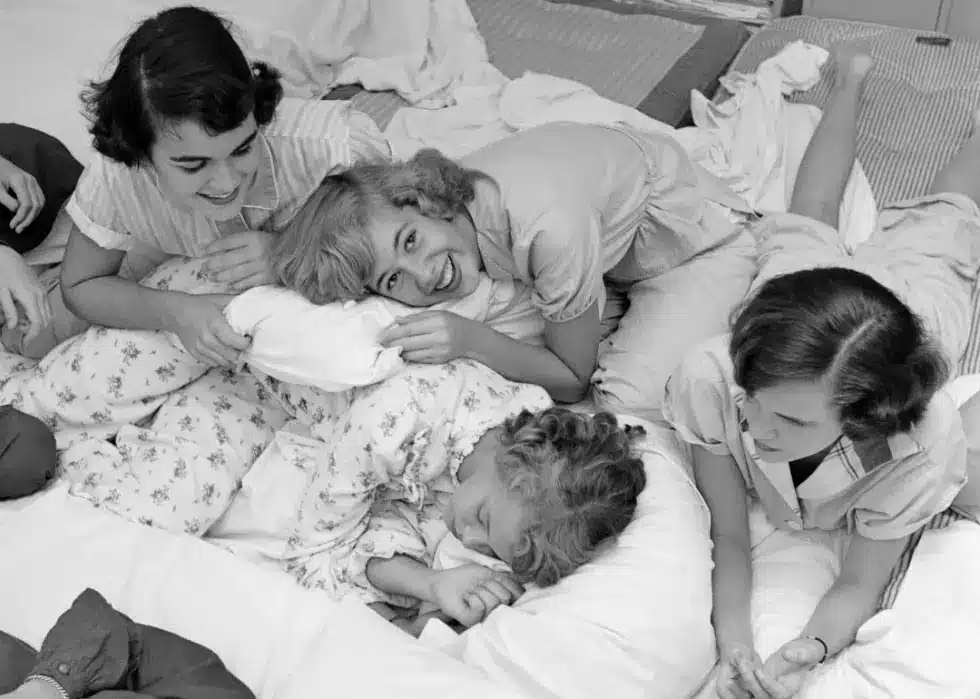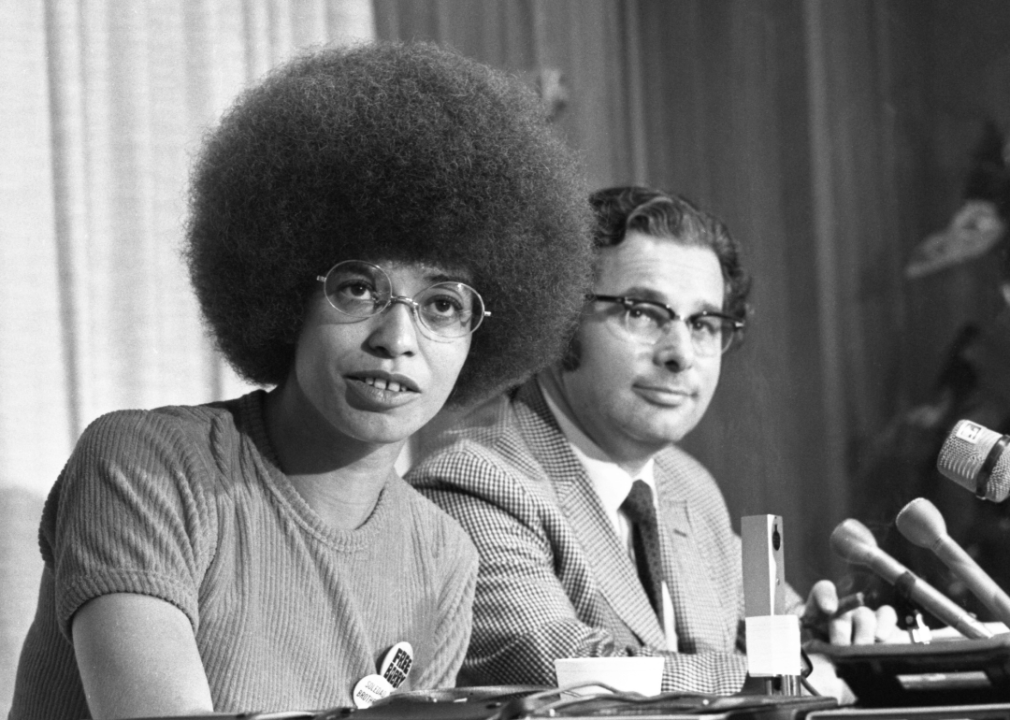I was born in the ’60s and so were these words from the 1960s. However, lest you think these are all hippie slang words, keep reading. You’ll be surprised at how many words and phrases we use regularly today did not exist 50-plus years ago.

23 words that were born in the 1960s
To see which words shaped the past, Stacker compiled a list of 25 new words born in the 1960s. It did that by consulting Merriam-Webster’s Time Traveler. This helped to identify words first written or published in English between 1960 and 1969.
It’s worth noting that words on this list were written or printed in English in these specific contexts for the first time in the 1960s. However, that doesn’t mean they didn’t exist in our vernacular. They just weren’t officially documented, such as by the Merriam-Webster Word of the Year.
For instance, “Black Friday” originally described a gold-based stock market crash in the 1800s. As you may know, now it’s most associated with a post-Thanksgiving shopping event.
Each day, Merriam-Webster editors comb publications — books, newspapers and magazines, for instance — to look for new words. When they discover that there are enough citations in various published materials to show a word is actually used widely, then dictionary editors write an entry.
It’s painstaking, never-ending work, especially considering an estimated 1,000 words enter our vocabularies every year. Still, the results can paint a picture of an era, and sometimes — like the words from the 1960s — it’s amazing what they come up with.
From dog breeds to demographic changes, here are 23 words from the 1960s that became officially recognized for their modern meaning.
Affirmative action

Photo credit: Douglas McFadd // Getty Images
Before President John F. Kennedy issued an executive order in 1961 so that there were equal employment opportunities for applicants regardless of “race, creed, color or national origin,” most people had no idea what affirmative action actually meant.
Nowadays, affirmative action is designed to alleviate unlawful discrimination against certain demographic groups regarding opportunities like college admissions and job hireability. However, the U.S. Supreme Court decided in 2023 to end affirmative action in college admissions.
Afro

Photo credit: Bettmann Archive // Getty Images
An afro is a Black hairstyle featuring tight curls in a rounded, full shape. Many prominent civil rights activists, such as Angela Davis and Jesse Jackson, wore this hairstyle in the 1960s, symbolizing Black liberation, beauty, and pride. It is having a resurgence in the 2020s.
Baby boomer

Photo credit: Bettmann // Getty Images
Because I was born in 1965, technically I’m not a baby boomer. I’m GenX, the generation that gets left out of everything. But I digress.
Anyway, though the term “baby boom” dates to the 19th century, the term “baby boomer” was later used to refer to the generation of Americans born during the major spike in U.S. births between 1946 and 1964. This spike followed the end of World War II.
Baby boom was first used in a 1963 Newport News Daily Press article. This article covered a spike in college applications now that the first members of the Baby Boom generation were approaching adulthood.
Black Friday

Photo credit: Bert Hardy Advertising Archive // Getty Images
The first use of “Black Friday” dates back to 1869. It described the day gold prices dropped steeply, causing a U.S. market crash.
The modern, post-Thanksgiving shopping meaning of the phrase originated in Philadelphia in the early ’60s. That was when cops used it to describe the dreaded traffic jams surrounding retail stores on that day.
That’s interesting because I always thought Black Friday signaled the day in the fiscal year when department stores went from being in the red (not making money) to being in the black (turning a profit). According to The History Channel, this shift in vernacular occurred in the 1980s.
Bubblegum

Photo credit: Debrocke/ClassicStock // Getty Images
Beginning in 1969, bubblegum didn’t exclusively refer to chewing gum anymore. Instead, people used it to describe media specifically catering to preteens and teenagers—most noticeably in music. An entire “bubblegum pop” subgenre emerged featuring upbeat, simple songs aimed at young audiences. Notable bubblegum pop artists of the time included the Archies, the Partridge Family, and the Ohio Express.

Npudov // Shutterstock
Cochlear implant
Cochlear implants are electronic devices that help give a sense of sound to deaf people and people with hearing loss. They were first invented in 1961 by American surgeon William House and engineer Jack Urban. The first implants were done that same year in Los Angeles by Dr. House and neurosurgeon Dr. John Doyle.
Daily Mirror/Mirrorpix/Mirrorpix via Getty Images
Cyborg
Cyborgs—part-human, part-machine people—are abundant in science fiction, but they weren’t referred to as such until fairly recently. In 1960, Manfred E. Clynes and Nathan S. Kline coined the term while hypothesizing about the future potential need to enhance humans as space exploration first took off. Now we just call them robots, am I right?

Daily Record/Mirrorpix/Mirrorpix via Getty Images
Dance-off
Dance-offs consist of competitions between dancers who must out-dance their opponents. The term became popular in 1967 when the dance and music program “American Bandstand” introduced a dance contest involving couples.
Daily Herald Archive/National Science & Media Museum/SSPL via Getty Images
Down syndrome
People with Down syndrome have an extra chromosome, leading their brains and bodies to develop differently. It was originally known by other, more derogatory terms. Eventually, geneticists and allies of the Down syndrome community lobbied for the name change. The World Health Organization officially approved this designation in 1965.

Bettmann // Getty Images
Gaslighting
Gaslighting is an abuse tactic where someone manipulates you so that you doubt the reliability of your own thoughts and perception of reality. It dates back to British novelist-playwright Patrick Hamilton’s 1938 play “Gas Light” and its subsequent 1944 American film adaptation. It wasn’t until 1961 when someone mentioned it outside of fiction. That was in A.S.C. Wallace’s book “Culture and Personality.” Of course, in modern times, sadly we hear more about gaslighting.

Lazy_Bear // Shutterstock
Jack Russell terrier
Jack Russell terriers, the dog breed, have been around forever. However, it wasn’t until 1961 that they got their official breed name.
They’re named for English clergyman John “Jack” Russell. An avid huntsman, Reverend Russell bred these terriers to have great stamina and courage, perfect for chasing game.
Speaking of new breeds, here are the newest AKC-recognized dog breeds in the 21st century.
Knockoff

Photo credit: Evening Standard/Hulton Archive // Getty Images
Knockoffs are copies of popular goods, such as fashion brands or artwork. Knockoffs aren’t illegal as long as consumers don’t mistake them for the original brands.
Counterfeits, however, use a well-known brand’s trademark and closely resemble the original. These are illegal and can set copycats back millions of dollars.
These days, shoppers are less likely to use the term knockoff. You’re more likely to hear words like “dupes” or “copycats” for lower-cost fashion items.
Magnetic levitation

Photo credit: TORU YAMANKA/AFP via Getty Images
In the age of “The Jetsons,” it’s unsurprising that magnetic levitation came into the lexicon. The first scientists to receive a magnetic levitation train design patent were James Powell and Gordon Danby of Brookhaven National Laboratory. However, it was only in 2003 that Powell’s idea came to life commercially in Shanghai. If that’s the case, then how does the monorail at Disney World run?
Midlife crisis

Photo credit: H. Armstrong Roberts/ClassicStock // Getty Images
Middle age. We women of a certain understand that term well, especially when coupled with menopause. However, it was until 1965 when Canadian psychoanalyst Elliott Jaques published a paper that “midlife crisis” became part of our regular language.
Military-industrial complex

Photo credit: Bettmann // Getty Images
A military-industrial complex forms when the military forges informal alliances with defense contractors and politicians. It gained popularity after President Dwight D. Eisenhower used the phrase during his 1961 farewell address, warning of the dangers of misplaced power.
Monkeypox

Photo credit: angellodeco // Shutterstock
These days we know monkeypox—now known as mpox—well. That’s after a 2022 outbreak that eventually spanned 87,000 cases in 170 countries.
However, scientists first used the word “monkeypox” in 1960. It was when they discovered this disease that people can get if they come into contact with open wounds or bodily fluids from infected people or animals.
Ob-gyn

Photo credit: Friends Stock // Shutterstock
The word ob-gyn combines the fields of obstetrics (concerning all things pregnancy and childbirth) and gynecology (concerning all things reproductive health), referring to medical professionals who work in both fields.
Although the word was coined in 1960, gynecology isn’t a word born in the 1960s. It is one of the oldest medicinal branches, dating back to ancient Egyptian times. These days some ob-gyn docs work within concierge medicine practices.
One-liner

Photo credit: Debrocke/ClassicStock // Getty Images
If you’ve ever delivered a witty, short joke, congratulations! You’ve uttered a one-liner, a popular comedy term that became official in 1962.
Sudden infant death syndrome

Photo credit: GMars // Shutterstock
Sudden infant death syndrome, commonly called SIDS, was first coined in 1969. It focused people’s attention on healthy infants unexpectedly dying before one year of age.
Telenovela

Photo credit: Bettmann // Getty Images
Telenovelas are popular Latin American dramas whose melodramatic storylines and abundant plot twists have much in common with their American soap opera counterparts. First popularized as radio dramas in the 1930s, telenovelas took off in countries like Brazil and Cuba in the 1950s. By the next decade, they featured storylines tackling taboo onscreen topics like violence, incest, and sex.
Theme park

Photo credit: Albert Moote/Michael Ochs Archives // Getty Images
In 1960, “theme park” was first used to describe amusement parks whose attractions and structure involved a specific theme. The term’s rise in popularity also coincided with the popularity of Disneyland, which opened in 1955.
While amusement parks had already existed, offering people a variety of rides and games, at Disneyland, these were now attractions that all clung to a central theme, where rides, shops, venues, and games were all coordinated.
Vibe

Photo credit: Graphic House/Hulton Archive // Getty Images
Vibe has had a colorful history. In 1935, it first meant the musical instrument vibraphone. In the late 1960s, “vibe” meant a distinctive feeling or quality given off by a place, person, or thing.
The term became popular as a way to respond to fears that conforming to societal norms took away the excitement of life. By 1971, it took on yet another sense, which meant to jive or be in harmony with someone. Then in the 1990s Vibe was something else entirely — a music magazine devoted to hip hop. Sadly, it folded in 2014. Now it lives online only.
Ziplock

Photo credit: Ahanov Michael // Shutterstock
Life without ziplocks can be hard to imagine these days, but Ziploc bags were only tested in public in 1968—the same year “ziplock” was added to the dictionary.
Steven Ausnit, who developed Ziplocs, first began testing plastic zippers in 1951. By 1962, the prototype included a plastic bag and a separate zipper attachment. It was in 1965 when the zipper and bag finally came together with its iconic press-and-seal function.
Story editing by Carren Jao. Copy editing by Paris Close. Abby Monteil contributed.

